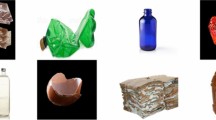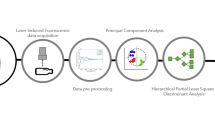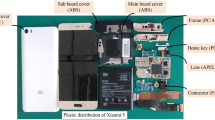Abstract
Plastic pollution is a global issue of increasing health concern, thus requiring innovative waste management. In particular, there is a need for advanced methods to identify and classify the different types of plastics. Near-infrared spectroscopy is currently operational in some waste-sorting facilities, yet remains challenging to discriminate different black plastics because black targets have low reflectance in some spectral regions. Here we used partial least squares discrimination analysis, soft independent modeling of class analogy, linear discriminant analysis and convolutional neural network to classify the plastics. We analyzed 159 plastic samples, including 84 black plastics, made of high impact polystyrene, acrylonitrile butadiene styrene, high-density polyethylene, polyethylene terephthalate, polyamide 66, polycarbonate and polypropylene. Results show that the convolutional neural network model yielded an accuracy up to 98%, whereas other models displayed accuracy of 57–70%. Overall, convolutional neural network analysis of infrared plastic data is promising to solve the bottleneck problem of black plastic discrimination.



Similar content being viewed by others
Abbreviations
- ABS:
-
Acrylonitrile butadiene styrene
- CNN:
-
Convolutional neural network
- HDPE:
-
High-density polyethylene
- HIPS:
-
High-impact polystyrene
- LDA:
-
Linear discriminant analysis
- NIR:
-
Near-infrared spectroscopy
- PA66:
-
Polyamide 66
- PC:
-
Polycarbonate
- PET:
-
Polyethylene terephthalate
- PLS-DA:
-
Partial least squares discrimination analysis
- PP:
-
Polypropylene
- SIMCA:
-
Soft independent modeling of class analogy
References
Acquarelli J, van Laarhoven T, Gerretzen J, Tran TN, Buydens LMC, Marchiori E (2017) Convolutional neural networks for vibrational spectroscopic data analysis. Anal Chim Acta 954:22–31. https://doi.org/10.1016/j.aca.2016.12.010
Alassali A, Fiore S, Kuchta K (2018) Assessment of plastic waste materials degradation through near infrared spectroscopy. Waste Manag 82:71–81. https://doi.org/10.1016/j.wasman.2018.10.010
Becker W, Sachsenheimer K, Klemenz M (2017) Detection of black plastics in the middle infrared spectrum (MIR) using photon up-conversion technique for polymer recycling purposes. Polymers 9:9. https://doi.org/10.3390/polym9090435
Bevilacqua M, Marini F (2014) Local classification: locally weighted–partial least squares-discriminant analysis (LW–PLS-DA). Anal Chim Acta 838:20–30. https://doi.org/10.1016/j.aca.2014.05.057
Camacho W, Karlsson S (2001) NIR, DSC, and FTIR as quantitative methods for compositional analysis of blends of polymers obtained from recycled mixed plastic waste. Polym Eng Sci 41:1626–35. https://doi.org/10.1002/pen.10860
Chu Y, Huang C, **e X, Tan B, Kamal S, **ong X (2018) Multilayer hybrid deep-learning method for waste classification and recycling. Comput Intell Neurosci 2018:1–9. https://doi.org/10.1155/2018/5060857
Cui C, Fearn T (2018) Modern practical convolutional neural networks for multivariate regression: applications to NIR calibration. Chemom Intell Lab Syst 182:9–20. https://doi.org/10.1016/j.chemolab.2018.07.008
Froelich D, Maris E, Haoues N, Chemineau L, Renard H, Abraham F, Lassartesses R (2007) State of the art of plastic sorting and recycling: feedback to vehicle design. Miner Eng 20:902–912. https://doi.org/10.1016/j.mineng.2007.04.020
Fuentes-García M, Maciá-Fernández G, Camacho J (2018) Evaluation of diagnosis methods in PCA-based Multivariate Statistical Process Control. Chemom Intell Lab Syst 172:194–210. https://doi.org/10.1016/j.chemolab.2017.12.008
Gerhardt N, Schwolow S, Rohn S, Pérez-Cacho PR, Galán-Soldevilla H, Arce L, Weller P (2019) Quality assessment of olive oils based on temperature-ramped HS-GC-IMS and sensory evaluation: comparison of different processing approaches by LDA, kNN, and SVM. Food Chem 278:720–728. https://doi.org/10.1016/j.foodchem.2018.11.095
Gerretzen J, Szymanska E, Jansen JJ, Bart J, van Manen HJ, van den Heuvel ER, Buydens LM (2015) Simple and Effective Way for Data Preprocessing Selection Based on Design of Experiments. Anal Chem 87:12096–12103. https://doi.org/10.1021/acs.analchem.5b02832
Gyawali D, Regmi A, Shakya A, Gautam A, Shrestha S (2020) Comparative analysis of multiple deep CNN models for waste classification. https://arxiv.org/abs/2004.02168
Kassouf A, Maalouly J, Rutledge DN, Chebib H, Ducruet V (2014) Rapid discrimination of plastic packaging materials using MIR spectroscopy coupled with independent components analysis (ICA). Waste Manage 34:2131–2138. https://doi.org/10.1016/j.wasman.2014.06.015
Li J, Wu GQ, Xu ZM (2015) Tribo-charging properties of waste plastic granules in process of tribo-electrostatic separation. Waste Manage 35:36–41. https://doi.org/10.1016/j.wasman.2014.10.001
Macho S, Larrechi MS (2002) Near-infrared spectroscopy and multivariate calibration for the quantitative determination of certain properties in the petrochemical industry. Trac-Trends Anal Chem 21:799–806. https://doi.org/10.1016/s0165-9936(02)01202-5
Marca FL, Moroni M, Cherubini L, Lupo E, Cenedese A (2012) Separation of plastic waste via the hydraulic separator Multidune under different geometric configurations. Waste Manag 32:1306–1315. https://doi.org/10.1016/j.wasman.2012.02.021
Nanda S, Berruti F (2021) Thermochemical conversion of plastic waste to fuels: a review. Environ Chem Lett 19:123–148. https://doi.org/10.1007/s10311-020-01094-7
Ng W, Minasny B, Montazerolghaem M, Padarian J, Ferguson R, Bailey S, McBratney AB (2019) Convolutional neural network for simultaneous prediction of several soil properties using visible/near-infrared, mid-infrared, and their combined spectra. Geoderma 352:251–267. https://doi.org/10.1016/j.geoderma.2019.06.016
Othman AR, Hasan HA, Muhamad MH, Ismail N, Abdullah SRS (2021) Microbial degradation of microplastics by enzymatic processes: a review. Environ Chem Lett. https://doi.org/10.1007/s10311-021-01197-9
Padervand M, Rhimi B, Wang C (2020) One-pot synthesis of novel ternary Fe3N/Fe2O3/C3N4 photocatalyst for efficient removal of rhodamine B and CO2 reduction. J Alloy Compd 852:156955. https://doi.org/10.1016/j.jallcom.2020.156955
Padervand M, Lichtfouse E, Robert D, Wang C (2020) Removal of microplastics from the environment: a review. Environ Chem Lett 18:807–28. https://doi.org/10.1007/s10311-020-00983-1
Padervand M, Ghasemi S, Hajiahmadi S, Wang C (2021) K4Nb6O17/Fe3N/α-Fe2O3/C3N4 as an enhanced visible light-driven quaternary photocatalyst for acetamiprid photodegradation, CO2 reductieon, and cancer cells treatment. Appl Surf Sci 544:148939. https://doi.org/10.1016/j.apsusc.2021.148939
Rani M, Marchesi C, Federici S, Rovelli G, Depero LE (2019) Miniaturized near-infrared (MicroNIR) spectrometer in plastic waste sorting. Materials 12:2740. https://doi.org/10.3390/ma12172740
Rozenstein O, Puckrin E, Adamowski J (2017) Development of a new approach based on midwave infrared spectroscopy for post-consumer black plastic waste sorting in the recycling industry. Waste Manag 68:38–44. https://doi.org/10.1016/j.wasman.2017.07.023
Shen HT, Pugh RJ, Forssberg E (2002) Floatability, selectivity and flotation separation of plastics by using a surfactant. Colloids Surf-Physicochem Eng Aspects 196:63–70. https://doi.org/10.1016/s0927-7757(01)00706-3
Signoret C, Caro-Bretelle AS, Lopez-Cuesta JM, Ienny P, Perrin D (2019) MIR spectral characterization of plastic to enable discrimination in an industrial recycling context: I. Specific case of styrenic polymers. Waste Manag 95:513–25. https://doi.org/10.1016/j.wasman.2019.05.050
Vanden Branden K, Hubert M (2005) Robust classification in high dimensions based on the SIMCA Method. Chemom Intell Lab Syst 79:10–21. https://doi.org/10.1016/j.chemolab.2005.03.002
Wang Z, Qin Y, Li W, Yang W, Meng Q, Yang J (2019) Microplastic contamination in freshwater: first observation in Lake Ulansuhai, Yellow River Basin, China. Environ Chem Lett 17:1821–1830. https://doi.org/10.1007/s10311-019-00888-8
Worrell E, Reuter MA (2014) Chapter 2-definitions and terminology: 9–16. https://doi.org/https://doi.org/10.1016/B978-0-12-396459-5.00002-7
Xu Y, Ma J, Liaw A, Sheridan RP, Svetnik V (2017) Demystifying Multi-Task Deep Neural Networks for Quantitative Structure-Activity Relationships. J Chem Inf Model 57:2490–504. https://doi.org/10.1021/acs.jcim.7b00087
Zhang C-C, Sahajwalla V, Zhang F-S (2014) Tetrabromobisphenol A recovery from computer housing plastic by a new solvothermal process. Environ Chem Lett 12:347–352. https://doi.org/10.1007/s10311-014-0452-8
Zhang XC, Gu F, **e J, Zhang CQ, Fu JZ, Zhao P (2019) Magnetic projection: a novel separation method and its first application on separating mixed plastics. Waste Manage 87:805–813. https://doi.org/10.1016/j.wasman.2019.03.008
Zheng H, Gu Y (2021) EnCNN-UPMWS: waste classification by a CNN ensemble using the UPM weighting strategy. Electronics 10:427. https://doi.org/10.3390/electronics10040427
Zheng Y, Bai J, Xu J, Li X, Zhang Y (2018) A discrimination model in waste plastics sorting using NIR hyperspectral imaging system. Waste Manag 72:87–98. https://doi.org/10.1016/j.wasman.2017.10.015
Zhu S, Chen H, Wang M, Guo X, Lei Y, ** G (2019) Plastic solid waste identification system based on near infrared spectroscopy in combination with support vector machine. Adv Ind Eng Polym Res 2:77–81. https://doi.org/10.1016/j.aiepr.2019.04.001
Zulkifley MA, Mustafa MM, Hussain A, Mustapha A, Ramli S (2014) Robust identification of polyethylene terephthalate (PET) plastics through bayesian decision. PLoS ONE 9:20. https://doi.org/10.1371/journal.pone.0114518
Acknowledgements
Thanks to the China Nanchang Customs providing the plastic samples and the corresponding chemistry information. And the authors would like to thank Yue Huang and Qianqian Li for the English language review. This research did not receive any specific grant from funding agencies in the public, commercial or not-for-profit sectors.
Author information
Authors and Affiliations
Corresponding authors
Additional information
Publisher's Note
Springer Nature remains neutral with regard to jurisdictional claims in published maps and institutional affiliations.
Supplementary Information
Below is the link to the electronic supplementary material.
Rights and permissions
About this article
Cite this article
**a, J., Huang, Y., Li, Q. et al. Convolutional neural network with near-infrared spectroscopy for plastic discrimination. Environ Chem Lett 19, 3547–3555 (2021). https://doi.org/10.1007/s10311-021-01240-9
Received:
Accepted:
Published:
Issue Date:
DOI: https://doi.org/10.1007/s10311-021-01240-9




